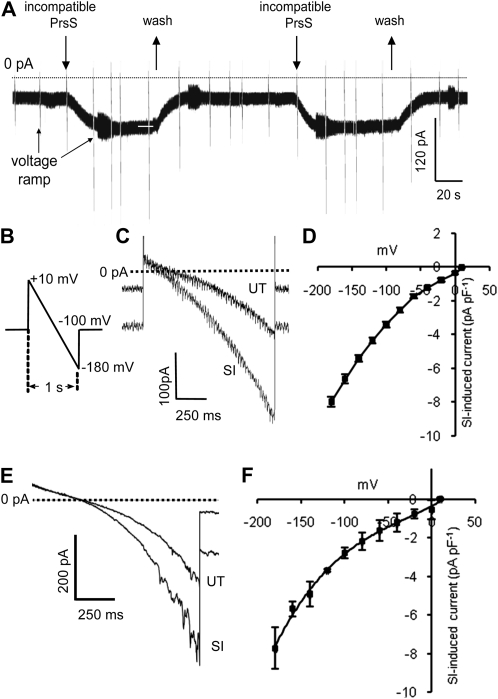Figure 1.
PrsS stimulates a ligand-gated ion Ca2+-permeable conductance. SI was induced by the addition of PrsS3 + PrsS8 to pollen protoplasts (haplotype S3 or S8), bathed in Ca2+-containing saline. A, Whole-cell current record shows induction of inward current by PrsS (10 μg mL−1) in a whole-cell-clamped pollen protoplast (Vh = −100 mV). Incompatible PrsS was applied by bath perfusion (indicated by arrows above traces). Inward current was activated immediately upon arrival of PrsS in the recording chamber and stabilized within 20 s. Upon washout of PrsS (upward arrows), the current returned to control levels. Reapplication of PrsS induced a second, identical inward current. Responses to voltage ramps applied before and during PrsS exposure appear as brief current excursions (arrows). B, Cartoon of the ramp protocol used for all experiments except those in Figure 2. Cells were stepped from −100 mV (holding voltage) to 10 mV followed by a linear ramp (duration of 1 s) to −180 mV; an interval of 10 to 20 s was allowed between ramps. C, Representative ramp-induced, whole-cell currents obtained in an untreated pollen protoplast bathed in Ca2+-containing saline before (UT) and after SI induction (SI) by PrsS addition. The dashed line indicates zero current. SI increased the holding current before application of the voltage ramp and greatly increased inward current at more negative potentials. D, I-V curve (mean ± se; n = 41) for SI-induced current in protoplasts bathed in Ca2+-containing saline. E, Representative ramp-induced, whole-cell PrsS-induced Ca2+ currents obtained before (UT) and after PrsS addition (SI) to a protoplast bathed in Ca2+-containing saline, using K+ as the backfill internal solution. The dashed line indicates zero current. SI increased the holding current before application of the voltage ramp and greatly increased inward current at more negative potentials. F, I-V curve (mean ± se; n = 3) for SI-induced current in protoplasts, using K+ in the backfill, internal solution.

